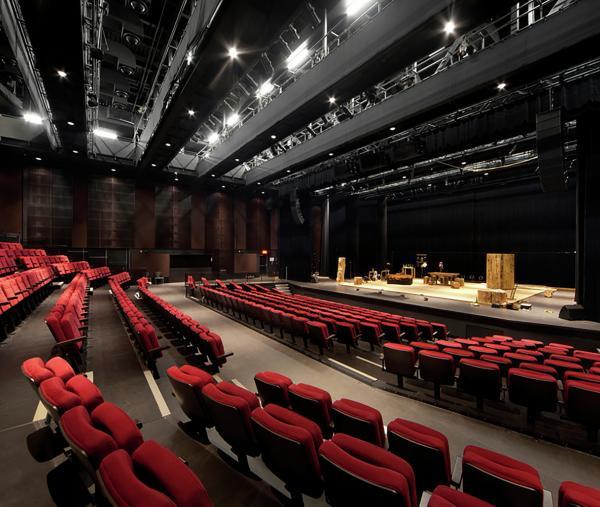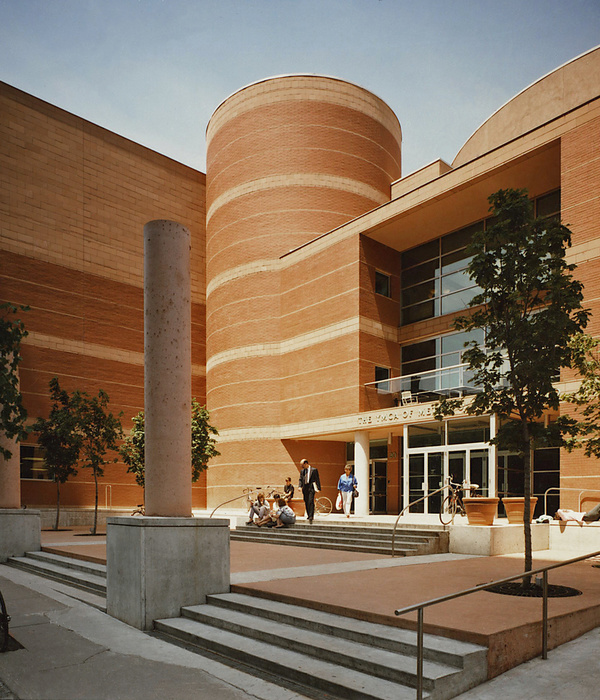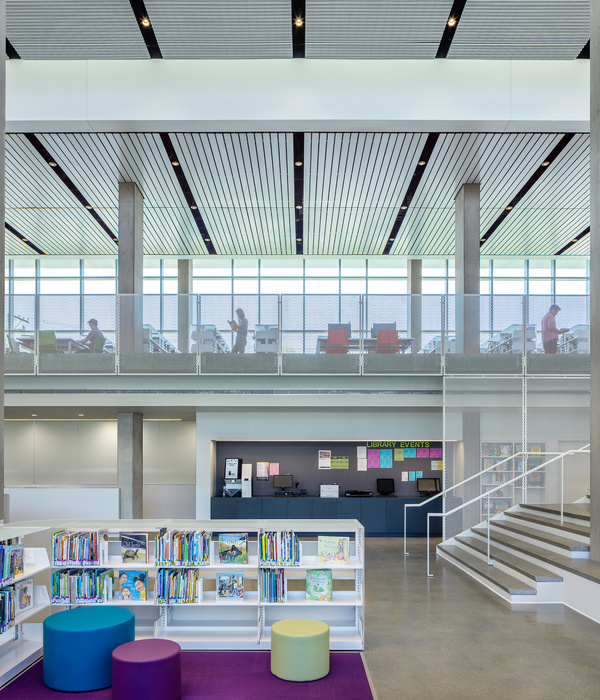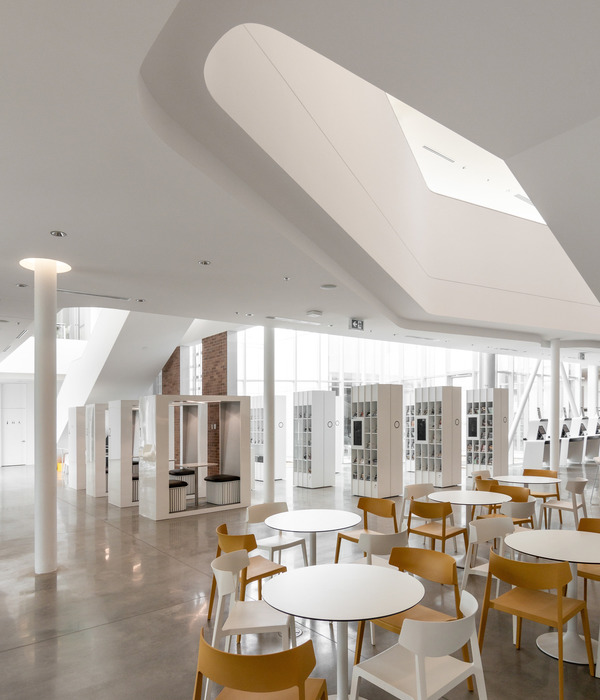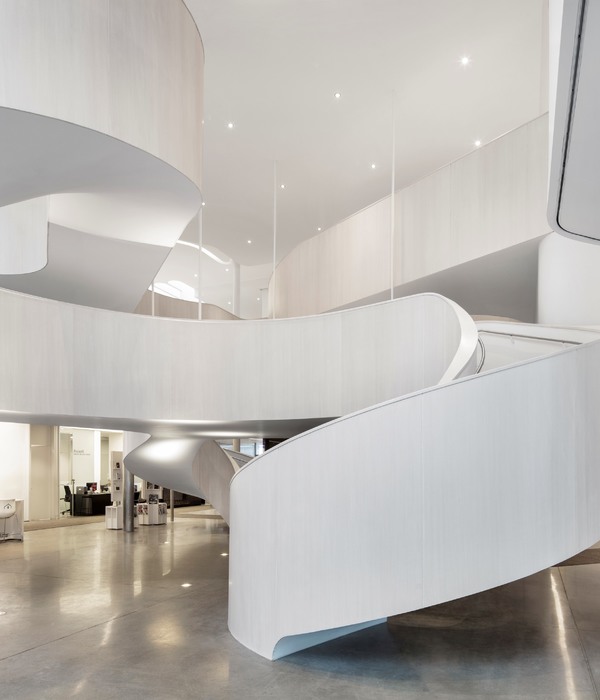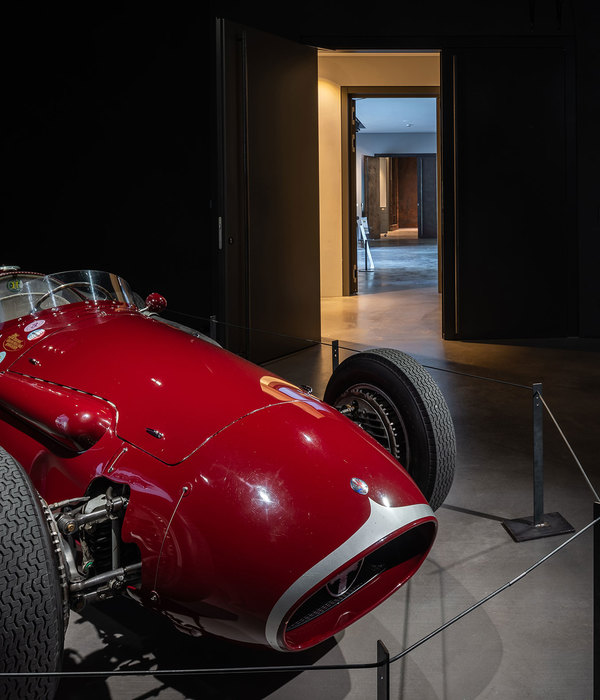在过去的五十年里,成都一直是中国科幻作品的主要创作基地,这里孕育了众多中国知名作家。新落成的成都科幻博物馆展示了成都对中国科幻小说在世界范围内的发展与普及所做出的贡献。新馆在开幕之际举办了世界科幻大会(Worldcon)和雨果奖(Hugo Awards),这也是世界科幻大会和雨果奖首次在中国举办。
Launching the careers of many renowned Chinese authors over the past five decades, Chengdu is the country’s leading incubator of science fiction writing. Showcasing the city’s contribution to the genre’s evolution and popularity around the world, the new Chengdu Science Fiction Museum has opened by hosting the World Science Fiction Convention (Worldcon) and Hugo Awards, the first time the events have been held in China.
▼项目视频,Project video © Zhou Rui
在绵延山脉与茂密森林的包围下,成都在其丰富的历史中发展出独特的当地文化,其中就包括著名的三星堆文明,而三星堆遗址出土的青铜雕刻面具更是激发了人们对于神秘幻象和外星文明的想象。作为中国西南部四川省的省会,成都已经发展成为拥有2000多万人口的新一线城市,并成为了重要的全球科学创新和研究中心。
Surrounded by mountain ranges and forests, the city of Chengdu has cultivated unique local traditions and culture rooted in its rich history that includes the celestial forms within the carvings and masks of the Bronze Age Sanxingdui civilization. The capital of Sichuan province in Southwest China, Chengdu has grown to over 20 million residents as an important center of scientific innovation and research.
▼场地环境,Site environment © Lan Dongjie
全新打造的成都科幻博物馆位于成都郫都区科技创新城的菁蓉湖畔,其设计与湖岸的自然景观相结合,定义出由人行道连接的活动节点,参观者可以从城市和附近的地铁站步行至周围的公园,继而进入建筑的中心;这场发现之旅交织于多层级的室内空间和户外广场,将博物馆的展览、教育设施、咖啡馆以及其他设施联系起来。
At the core of Jingrong Lake the new Chengdu Science Fiction Museum is within the Science & Innovation New City of Chengdu’s Pidu District. Integrating with the natural landscapes along the lakeshore, the museum’s design defines nodes of activity connected by pedestrian routes that extend from the city through the surrounding parkland into the heart of the building; creating a journey of discovery that weaves between indoor and outdoor plazas at multiple levels to link the museum’s exhibition galleries, educational facilities, cafes and other amenities.
▼鸟瞰,Bird’s eye view © Arch-Exist
在回应独特场地条件的同时,设计还兼具了清晰的布局和功能性,看上去犹如从湖面上浮起。屋顶的流体形式从内部的一个中心点向外辐射,犹如一团以恒星为中心、正向外部扩大的星云,使能量场分散至许多不同的区域;参观者将被引入一道连通生活经验与想象力的大门。
Bringing together programmatic and functional clarity while responding to its unique site conditions, the museum appears to float above from the surface of the lake. The fluid forms of its roof radiate from a central point within, emulating an expanding nebula cloud with a star at its center – transforming the museum into a ‘star cloud’ that disperses energy fields into its many different zones; guiding visitors through a portal that connects our lived experience with our imagination.
▼夜景远观,Night view at distance © Arch-Exist
▼屋顶犹如一团向外部扩大的星云,The roof is like a nebula expanding outward © Arch-Exist
▼屋顶近景,Closer view © Arch-Exist
成都科幻博物馆占地59000平方米,包含展览馆、剧院、会议厅和配套的辅助空间,拥有极高的灵活性,可以举办类型广泛且多样的展览、会议和活动。采光优越的中央中庭和朝向壮观西岭雪山的巨大窗户将博物馆的内部空间与周围环境联系起来。
Incorporating maximum flexibility to host the widest variety of exhibitions, conferences and events, the 59,000 sq. m Chengdu Science Fiction Museum includes exhibition galleries, multi-function hall, conference centre and supporting ancillary spaces. The sky-lit central atrium and it’s large window facing the spectacular Xiling Mountain connect the museum’s interiors with their surrounding environment.
▼采光优越的中央中庭,Central atrium with excellent light © Arch-Exist
博物馆的设计符合中国绿色建筑发展规划的最高三星级标准,借助精确的数字建模分析,在构成、场地条件、太阳辐照与结构方面均实现了效率的最大化。自然混合通风能够优化成都温和的亚热带气候,为参观者和工作人员提供全年的舒适感受。嵌入博物馆大屋顶的光伏发电系统有助于满足建筑的能源需求。
Meeting the highest 3-Star standards of China’s Green Building Program, the museum’s design has been developed through detailed digital modelling analysis to maximize efficiencies in composition, site conditions, solar irradiation and structure. The museum’s natural hybrid ventilation optimizes Chengdu’s mild subtropical climate to provide comfort for visitors and staff throughout the year while photovoltaics within the museum’s large roof canopy contribute to meeting the building’s energy demands.
▼室内交通空间,Interior circulations pace © Arch-Exist
景观设计方面采用了当地的植物,可收集雨水并进行自然过滤和再利用,使菁蓉湖成为成都可持续排水系统的一个组成部分,这将有助于减轻洪水,并增加整个城市的生物多样性。
Landscaped with plants native to the region, the park surrounding the museum collects and stores rainwater for natural filtration and reuse, enabling Jingrong Lake to become an integral part of Chengdu’s sustainable drainage system that will mitigate flooding and increase biodiversity throughout the city.
▼会议厅,Conference hall © Arch-Exist
这场一年一度的大会创办于1939年,是全世界最大的科幻盛会。雨果奖以先锋科幻杂志《惊奇故事》的创办人雨果·根斯巴克的名字命名,自1955年起由世界科幻协会(World Science Fiction Association)在世界科幻大会上颁发,代表着对科幻小说和奇幻文学以及其他形式作品的最高认可。
2015年,中国作家刘慈欣凭《三体》第一部获得第73届雨果奖最佳长篇小说奖,2016年,作家郝景芳又凭《北京折叠》获得雨果奖最佳中短篇小说奖,使雨果奖在中国家喻户晓。
Established in 1939, WorldCon is the world’s largest science fiction event. Named after science fiction pioneer Hugo Gernsback, the Hugo Awards have been presented at Worldcon by the World Science Fiction Association since 1955 and are the highest recognition for science fiction and fantasy literature, as well as work in other media.
In 2015, Chinese author Liu Cixin’s ‘The Three-Body Problem’ won the 73rd Hugo Award for Best Novel, and in 2016 author Hao Jingfang’s work ‘Folding Beijing’ received the Hugo Award for Best Novelette; making the Hugo Awards a household name throughout China.
▼光影数字艺术走廊,Digital art corridor © Arch-Exist
连接着过去、现在与未来,成都科幻博物馆将成为一个充满活力的创新中心和城市聚集地。
Connecting the past, present and future, the Chengdu Science Fiction Museum will be a centre of inspiration and innovation for the city.
▼电梯内部,Elevator interior © Arch-Exist
Architect: Zaha Hadid Architects (ZHA) Design: Patrik Schumacher ZHA Project Directors: Satoshi Ohashi, Paulo Flores ZHA Project Associate: Yang Jingwen ZHA Project Architects: Juan Liu, Magda Smolinska ZHA Project Lead: Sven Torres ZHA Site Team: Chu Zhou, Shang Li, Lianyuan Ye, Meng Zhao ZHA Project Team: Andrei-Ciprian Cojocaru, Berkin Islam, Chu Zhou, Hao Wen, Jillian Nishi, Lianyuan Ye, Meng Zhao, Shang Li, Stefan Manousof, Sven Torres, Yang Liu, Yuling Ma, Xiaoying Li ZHA Competition Project Directors: Satoshi Ohashi, Paulo Flores ZHA Competition Associate: Yang Jingwen ZHA Competition Project Architects: Juan Liu, Magda Smolinska ZHA Competition Team: Andrei-Ciprian Cojocaru, Enoch Kolo, Jillian Nishi, Juan Montiel, Lianyuan Ye, Meng Zhao, Nan Jiang, Nastasja Mitrovic, Stefan Manousof, Yanran Lu, Yimeng Zhao, Yuling Ma ZHA Competition Sustainability Team: Aleksander Mastalski, Carlos Bausa Martinez Competition Visuals: Zaha Hadid Architects, ATCHAIN Consultants Executive Architect: Zaha Hadid Architects Local Architect: China South West Architecture Design Institute Structural Engineers: China South West Architecture Design Institute General Contractor: China Construction Third Engineering Bureau Group Façade Engineering: China South West Architecture Design Institute M&E Engineering: China South West Architecture Design Institute MEP: China South West Architecture Design Institute Fire Engineer: China South West Architecture Design Institute Landscape Consultant: Hangzhou Landscape Design Institute Lighting Design: LIGHTDESIGN, BPI Acoustic Consultant: SIADR Site Supervision: Sichuan Feihong Engineering Management Consulting Project Management: CR LAND Interior Local Design Institute: SIADR Exhibition Design Consultant: Chengdu Science Fiction Society
{{item.text_origin}}

